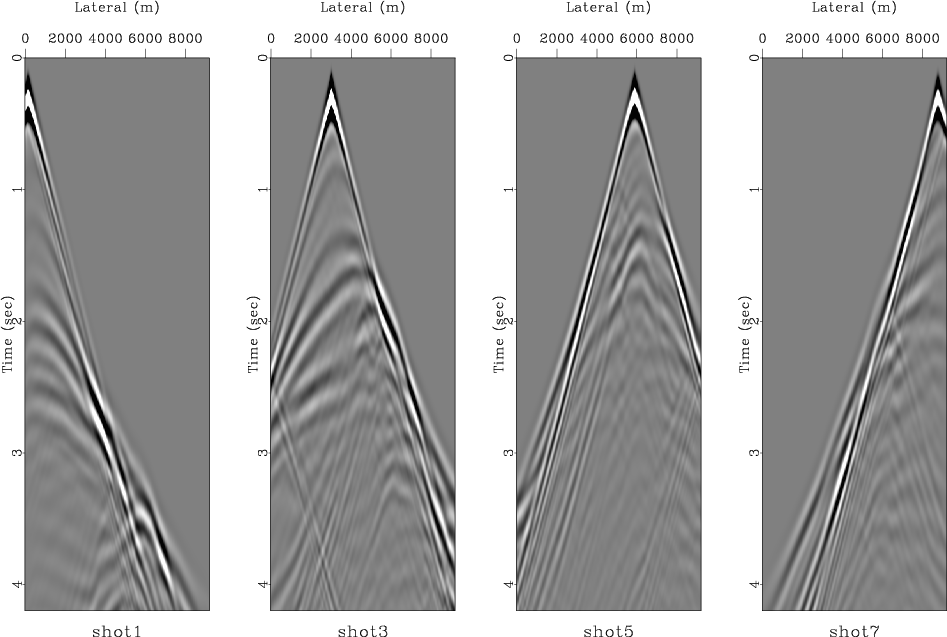|
|
|
|
From modeling to full waveform inversion: A hands-on tour using Madagascar |
It is convenient to perform adjoint simulation when reconstructing the incident wavefield backwards. The computation of FWI gradient can be done on the fly by adding several lines:
![\begin{lstlisting}
memset(sp0[0], 0, nz*nx*sizeof(float));
memset(sp1[0], 0, nz*...
...0=sp1; sp1=sp2; sp2=ptr;
ptr=gp0; gp0=gp1; gp1=gp2; gp2=ptr;
}
\end{lstlisting}](img34.png) Of course, to apply the steepest descent method for minimization of the misfit function for waveform inversion, a step length has to be determined at each iteration. You may use the estimation proposed by Pica et al. (1990, in the appendix) in your FWI code as RSFSRC/user/pyang/Mfwi2d.c.
Of course, to apply the steepest descent method for minimization of the misfit function for waveform inversion, a step length has to be determined at each iteration. You may use the estimation proposed by Pica et al. (1990, in the appendix) in your FWI code as RSFSRC/user/pyang/Mfwi2d.c.
The workflow for synthetic FWI test based on Marmousi model follows the several steps:
from rsf.proj import *
# marmvel.hh contains Marmousi model which can
# be downloaded from the server using Fetch.
Fetch('marmvel.hh','marm')
Flow('vel','marmvel.hh',
'''
dd form=native | window j1=8 j2=8 | sfsmooth rect1=3 rect2=3|
put label1=Depth unit1=m label2=Lateral unit2=m
''')
Plot('vel',
'''
grey color=j mean=y title="Marmousi model"
scalebar=y bartype=v barlabel="V"
barunit="m/s" screenratio=0.45 color=j labelsz=10 titlesz=12
''')
Flow('shots','vel',
'''
sfmodeling2d csdgather=n fm=4 amp=1 dt=0.0015 ns=7 ng=288 nt=2800
sxbeg=4 szbeg=2 jsx=45 jsz=0 gxbeg=0 gzbeg=3 jgx=1 jgz=0
''')
Plot('shots','grey color=g title=shot label2= unit2=',view=1)
Plot('shot1','shots',
'window n3=1 f3=0| grey title=shot1 label2=Lateral unit2=m')
Plot('shot3','shots',
'window n3=1 f3=2| grey title=shot3 label2=Lateral unit2=m')
Plot('shot5','shots',
'window n3=1 f3=4| grey title=shot5 label2=Lateral unit2=m')
Plot('shot7','shots',
'window n3=1 f3=6| grey title=shot7 label2=Lateral unit2=m')
Result('shotsnap','shot1 shot3 shot5 shot7',
'SideBySideAniso',vppen='txscale=2.')
# smoothed velocity model
Flow('smvel','vel','smooth repeat=6 rect1=8 rect2=10')
Plot('smvel',
'''
grey title="Initial model" wantitle=y allpos=y color=j
pclip=100 scalebar=y bartype=v barlabel="V" barunit="m/s"
screenratio=0.45 color=j labelsz=10 titlesz=12
''' )
Result('marm','vel smvel','TwoRows')
# use the over-smoothed model as initial model for FWI
Flow('vsnaps grads objs illums','smvel shots',
'''
sffwi2d shots=${SOURCES[1]}
grads=${TARGETS[1]} objs=${TARGETS[2]}
illums=${TARGETS[3]} niter=10 precon=y rbell=1
''')
Result('vsnaps',
'''
grey title="Updated velocity" allpos=y color=j pclip=100
scalebar=y bartype=v barlabel="V" barunit="m/s"
''')
Plot('vsnap1','vsnaps',
'''
window n3=1|grey title="Updated velocity, iter=1"
allpos=y color=j pclip=100 labelsz=10 titlesz=12
scalebar=y bartype=v barlabel="V" barunit="m/s"
''')
Plot('vsnap2','vsnaps',
'''
window n3=1 f3=1|grey title="Updated velocity, iter=2"
allpos=y color=j pclip=100 labelsz=10 titlesz=12
scalebar=y bartype=v barlabel="V" barunit="m/s"
''')
Plot('vsnap4','vsnaps',
'''
window n3=1 f3=3|grey title="Updated velocity, iter=4"
allpos=y color=j pclip=100 labelsz=10 titlesz=12
scalebar=y bartype=v barlabel="V" barunit="m/s"
''')
Plot('vsnap6','vsnaps',
'''
window n3=1 f3=5|grey title="Updated velocity, iter=6"
allpos=y color=j pclip=100 labelsz=10 titlesz=12
scalebar=y bartype=v barlabel="V" barunit="m/s"
''')
Plot('vsnap8','vsnaps',
'''
window n3=1 f3=7|grey title="Updated velocity, iter=8"
allpos=y color=j pclip=100 labelsz=10 titlesz=12
scalebar=y bartype=v barlabel="V" barunit="m/s"
''')
Plot('vsnap10','vsnaps',
'''
window n3=1 f3=9|grey title="Updated velocity, iter=10"
allpos=y color=j pclip=100 labelsz=10 titlesz=12
scalebar=y bartype=v barlabel="V" barunit="m/s"
''')
Result('vsnap','vsnap1 vsnap2 vsnap4 vsnap6 vsnap8 vsnap10',
'TwoRows')
Result('objs',
'''
sfput n2=1 label1=Iteration unit1= unit2= label2= |
graph title="Misfit function" dash=0 plotfat=5
grid=y yreverse=n
''')
End()
|

|
|---|
|
marm
Figure 4. Top: True Marmousi model; bottom: Initial model for FWI |
|
|

|
|---|
|
shotsnap
Figure 5. Shots from true Marmousi model |
|
|

|
|---|
|
vsnap
Figure 6. Inverted velocity during iterations |
|
|

|
|---|
|
objs
Figure 7. The misfit function decreases during iterations |
|
|
|
|
|
|
From modeling to full waveform inversion: A hands-on tour using Madagascar |